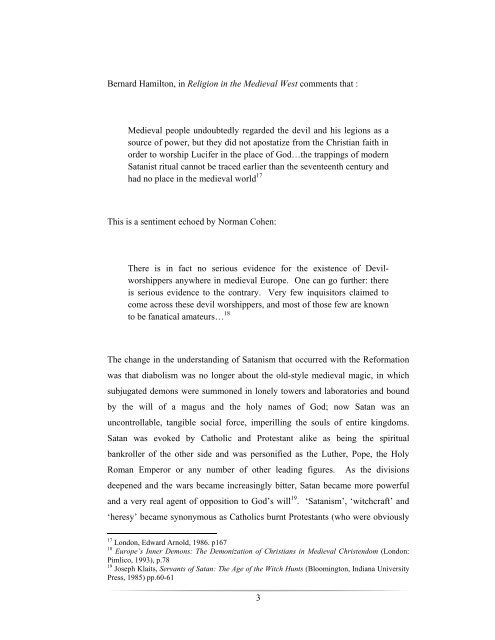Dreamers of the Dark: - Research Commons - The University of ...
Dreamers of the Dark: - Research Commons - The University of ...
Dreamers of the Dark: - Research Commons - The University of ...
You also want an ePaper? Increase the reach of your titles
YUMPU automatically turns print PDFs into web optimized ePapers that Google loves.
Bernard Hamilton, in Religion in <strong>the</strong> Medieval West comments that :<br />
Medieval people undoubtedly regarded <strong>the</strong> devil and his legions as a<br />
source <strong>of</strong> power, but <strong>the</strong>y did not apostatize from <strong>the</strong> Christian faith in<br />
order to worship Lucifer in <strong>the</strong> place <strong>of</strong> God…<strong>the</strong> trappings <strong>of</strong> modern<br />
Satanist ritual cannot be traced earlier than <strong>the</strong> seventeenth century and<br />
had no place in <strong>the</strong> medieval world 17<br />
This is a sentiment echoed by Norman Cohen:<br />
<strong>The</strong>re is in fact no serious evidence for <strong>the</strong> existence <strong>of</strong> Devilworshippers<br />
anywhere in medieval Europe. One can go fur<strong>the</strong>r: <strong>the</strong>re<br />
is serious evidence to <strong>the</strong> contrary. Very few inquisitors claimed to<br />
come across <strong>the</strong>se devil worshippers, and most <strong>of</strong> those few are known<br />
to be fanatical amateurs… 18<br />
<strong>The</strong> change in <strong>the</strong> understanding <strong>of</strong> Satanism that occurred with <strong>the</strong> Reformation<br />
was that diabolism was no longer about <strong>the</strong> old-style medieval magic, in which<br />
subjugated demons were summoned in lonely towers and laboratories and bound<br />
by <strong>the</strong> will <strong>of</strong> a magus and <strong>the</strong> holy names <strong>of</strong> God; now Satan was an<br />
uncontrollable, tangible social force, imperilling <strong>the</strong> souls <strong>of</strong> entire kingdoms.<br />
Satan was evoked by Catholic and Protestant alike as being <strong>the</strong> spiritual<br />
bankroller <strong>of</strong> <strong>the</strong> o<strong>the</strong>r side and was personified as <strong>the</strong> Lu<strong>the</strong>r, Pope, <strong>the</strong> Holy<br />
Roman Emperor or any number <strong>of</strong> o<strong>the</strong>r leading figures. As <strong>the</strong> divisions<br />
deepened and <strong>the</strong> wars became increasingly bitter, Satan became more powerful<br />
and a very real agent <strong>of</strong> opposition to God’s will 19 . ‘Satanism’, ‘witchcraft’ and<br />
‘heresy’ became synonymous as Catholics burnt Protestants (who were obviously<br />
17<br />
London, Edward Arnold, 1986. p167<br />
18<br />
Europe’s Inner Demons: <strong>The</strong> Demonization <strong>of</strong> Christians in Medieval Christendom (London:<br />
Pimlico, 1993), p.78<br />
19<br />
Joseph Klaits, Servants <strong>of</strong> Satan: <strong>The</strong> Age <strong>of</strong> <strong>the</strong> Witch Hunts (Bloomington, Indiana <strong>University</strong><br />
Press, 1985) pp.60-61<br />
3
















